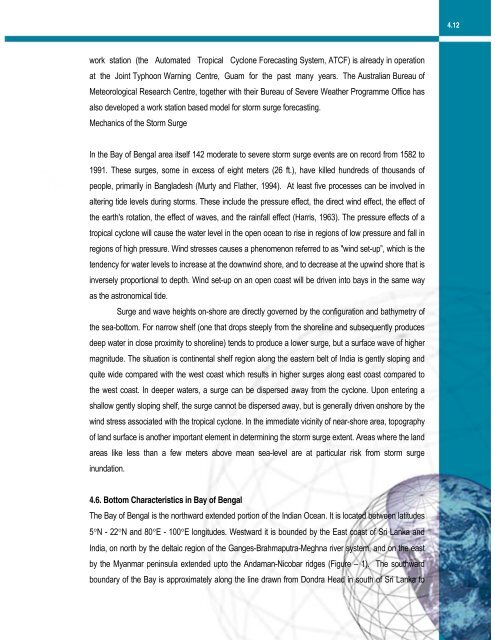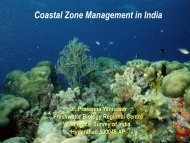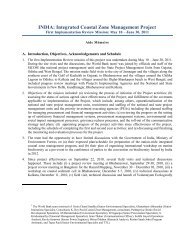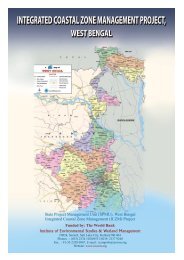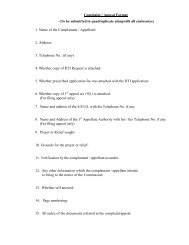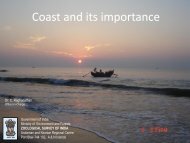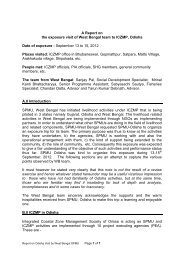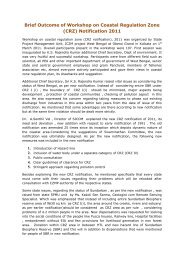Cyclone and Storm Surge - Iczmpwb.org
Cyclone and Storm Surge - Iczmpwb.org
Cyclone and Storm Surge - Iczmpwb.org
You also want an ePaper? Increase the reach of your titles
YUMPU automatically turns print PDFs into web optimized ePapers that Google loves.
4.12<br />
work station (the Automated Tropical <strong>Cyclone</strong> Forecasting System, ATCF) is already in operation<br />
at the Joint Typhoon Warning Centre, Guam for the past many years. The Australian Bureau of<br />
Meteorological Research Centre, together with their Bureau of Severe Weather Programme Office has<br />
also developed a work station based model for storm surge forecasting.<br />
Mechanics of the <strong>Storm</strong> <strong>Surge</strong><br />
In the Bay of Bengal area itself 142 moderate to severe storm surge events are on record from 1582 to<br />
1991. These surges, some in excess of eight meters (26 ft.), have killed hundreds of thous<strong>and</strong>s of<br />
people, primarily in Bangladesh (Murty <strong>and</strong> Flather, 1994). At least five processes can be involved in<br />
altering tide levels during storms. These include the pressure effect, the direct wind effect, the effect of<br />
the earth's rotation, the effect of waves, <strong>and</strong> the rainfall effect (Harris, 1963). The pressure effects of a<br />
tropical cyclone will cause the water level in the open ocean to rise in regions of low pressure <strong>and</strong> fall in<br />
regions of high pressure. Wind stresses causes a phenomenon referred to as "wind set-up”, which is the<br />
tendency for water levels to increase at the downwind shore, <strong>and</strong> to decrease at the upwind shore that is<br />
inversely proportional to depth. Wind set-up on an open coast will be driven into bays in the same way<br />
as the astronomical tide.<br />
<strong>Surge</strong> <strong>and</strong> wave heights on-shore are directly governed by the configuration <strong>and</strong> bathymetry of<br />
the sea-bottom. For narrow shelf (one that drops steeply from the shoreline <strong>and</strong> subsequently produces<br />
deep water in close proximity to shoreline) tends to produce a lower surge, but a surface wave of higher<br />
magnitude. The situation is continental shelf region along the eastern belt of India is gently sloping <strong>and</strong><br />
quite wide compared with the west coast which results in higher surges along east coast compared to<br />
the west coast. In deeper waters, a surge can be dispersed away from the cyclone. Upon entering a<br />
shallow gently sloping shelf, the surge cannot be dispersed away, but is generally driven onshore by the<br />
wind stress associated with the tropical cyclone. In the immediate vicinity of near-shore area, topography<br />
of l<strong>and</strong> surface is another important element in determining the storm surge extent. Areas where the l<strong>and</strong><br />
areas like less than a few meters above mean sea-level are at particular risk from storm surge<br />
inundation.<br />
4.6. Bottom Characteristics in Bay of Bengal<br />
The Bay of Bengal is the northward extended portion of the Indian Ocean. It is located between latitudes<br />
5°N - 22°N <strong>and</strong> 80°E - 100°E longitudes. Westward it is bounded by the East coast of Sri Lanka <strong>and</strong><br />
India, on north by the deltaic region of the Ganges-Brahmaputra-Meghna river system, <strong>and</strong> on the east<br />
by the Myanmar peninsula extended upto the Andaman-Nicobar ridges (Figure – 1). The southward<br />
boundary of the Bay is approximately along the line drawn from Dondra Head in south of Sri Lanka to


